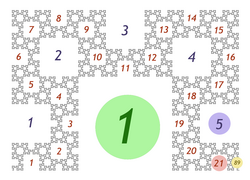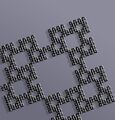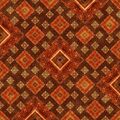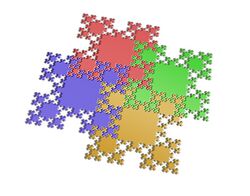Fibonacci word fractal
The Fibonacci word fractal is a fractal curve defined on the plane from the Fibonacci word.
Definition

This curve is built iteratively by applying the Odd–Even Drawing rule to the Fibonacci word 0100101001001...:
For each digit at position k:
- Draw a segment forward
- If the digit is 0:
To a Fibonacci word of length [math]\displaystyle{ F_n }[/math] (the nth Fibonacci number) is associated a curve [math]\displaystyle{ \mathcal{F}_n }[/math] made of [math]\displaystyle{ F_n }[/math] segments. The curve displays three different aspects whether n is in the form 3k, 3k + 1, or 3k + 2.
Properties
Some of the Fibonacci word fractal's properties include:[2][3]
- The curve [math]\displaystyle{ \mathcal{F_n} }[/math] contains [math]\displaystyle{ F_n }[/math] segments, [math]\displaystyle{ F_{n-1} }[/math] right angles and [math]\displaystyle{ F_{n-2} }[/math] flat angles.
- The curve never self-intersects and does not contain double points. At the limit, it contains an infinity of points asymptotically close.
- The curve presents self-similarities at all scales. The reduction ratio is [math]\displaystyle{ 1+\sqrt{2} }[/math]. This number, also called the silver ratio, is present in a great number of properties listed below.
- The number of self-similarities at level n is a Fibonacci number \ −1. (more precisely: [math]\displaystyle{ F_{3n+3}-1 }[/math]).
- The curve encloses an infinity of square structures of decreasing sizes in a ratio [math]\displaystyle{ 1+\sqrt{2} }[/math] (see figure). The number of those square structures is a Fibonacci number.
- The curve [math]\displaystyle{ \mathcal{F}_n }[/math]can also be constructed in different ways (see gallery below):
- Iterated function system of 4 and 1 homothety of ratio [math]\displaystyle{ 1/(1+\sqrt2) }[/math] and [math]\displaystyle{ 1/(1+\sqrt2)^2 }[/math]
- By joining together the curves [math]\displaystyle{ \mathcal{F}_{n-1} }[/math] and [math]\displaystyle{ \mathcal{F}_{n-2} }[/math]
- Lindenmayer system
- By an iterated construction of 8 square patterns around each square pattern.
- By an iterated construction of octagons
- The Hausdorff dimension of the Fibonacci word fractal is [math]\displaystyle{ 3\,\frac{\log\varphi}{\log(1+\sqrt 2)}\approx 1.6379 }[/math], with [math]\displaystyle{ \varphi = \frac{1+\sqrt{5}}{2} }[/math] the golden ratio.
- Generalizing to an angle [math]\displaystyle{ \alpha }[/math] between 0 and [math]\displaystyle{ \pi/2 }[/math], its Hausdorff dimension is [math]\displaystyle{ 3\,\frac{\log\varphi}{\log(1+a+\sqrt{(1+a)^2+1})} }[/math], with [math]\displaystyle{ a=\cos\alpha }[/math].
- The Hausdorff dimension of its frontier is [math]\displaystyle{ \frac{\log 3}{{\log(1+\sqrt 2})}\approx 1.2465 }[/math].
- Exchanging the roles of "0" and "1" in the Fibonacci word, or in the drawing rule yields a similar curve, but oriented 45°.
- From the Fibonacci word, one can define the «dense Fibonacci word», on an alphabet of 3 letters: 102210221102110211022102211021102110221022102211021... (sequence A143667 in the OEIS). The usage, on this word, of a more simple drawing rule, defines an infinite set of variants of the curve, among which:
- a "diagonal variant"
- a "svastika variant"
- a "compact variant"
- It is conjectured that the Fibonacci word fractal appears for every sturmian word for which the slope, written in continued fraction expansion, ends with an infinite sequence of "1"s.
Gallery
The Fibonacci tile
The juxtaposition of four [math]\displaystyle{ F_{3k} }[/math] curves allows the construction of a closed curve enclosing a surface whose area is not null. This curve is called a "Fibonacci tile".
- The Fibonacci tile almost tiles the plane. The juxtaposition of 4 tiles (see illustration) leaves at the center a free square whose area tends to zero as k tends to infinity. At the limit, the infinite Fibonacci tile tiles the plane.
- If the tile is enclosed in a square of side 1, then its area tends to [math]\displaystyle{ 2-\sqrt{2} = 0.5857 }[/math].
Fibonacci snowflake

The Fibonacci snowflake is a Fibonacci tile defined by:[5]
- [math]\displaystyle{ q_n = q_{n-1}q_{n-2} }[/math] if [math]\displaystyle{ n \equiv 2 \pmod 3 }[/math]
- [math]\displaystyle{ q_n = q_{n-1}\overline{q}_{n-2} }[/math] otherwise.
with [math]\displaystyle{ q_0=\epsilon }[/math] and [math]\displaystyle{ q_1=R }[/math], [math]\displaystyle{ L = }[/math] "turn left" and [math]\displaystyle{ R = }[/math] "turn right", and [math]\displaystyle{ \overline{R} = L }[/math].
Several remarkable properties:[5][6]
- It is the Fibonacci tile associated to the "diagonal variant" previously defined.
- It tiles the plane at any order.
- It tiles the plane by translation in two different ways.
- its perimeter at order n equals [math]\displaystyle{ 4F(3n+1) }[/math], where [math]\displaystyle{ F(n) }[/math] is the nth Fibonacci number.
- its area at order n follows the successive indexes of odd row of the Pell sequence (defined by [math]\displaystyle{ P(n)=2P(n-1)+P(n-2) }[/math]).
See also
References
- ↑ Ramírez, José L.; Rubiano, Gustavo N. (2014). "Properties and Generalizations of the Fibonacci Word Fractal", The Mathematical Journal, Vol. 16.
- ↑ Monnerot-Dumaine, Alexis (February 2009). "The Fibonacci word fractal", independent (hal.archives-ouvertes.fr).
- ↑ Hoffman, Tyler; Steinhurst, Benjamin (2016). "Hausdorff Dimension of Generalized Fibonacci Word Fractals". arXiv:1601.04786 [math.MG].
- ↑ Ramírez, Rubiano, and De Castro (2014). "A generalization of the Fibonacci word fractal and the Fibonacci snowflake", Theoretical Computer Science, Vol. 528, p.40-56. [1]
- ↑ Jump up to: 5.0 5.1 Blondin-Massé, Alexandre; Brlek, Srečko; Garon, Ariane; and Labbé, Sébastien (2009). "Christoffel and Fibonacci tiles", Lecture Notes in Computer Science: Discrete Geometry for Computer Imagery, p.67-8. Springer. ISBN:9783642043963.
- ↑ A. Blondin-Massé, S. Labbé, S. Brlek, M. Mendès-France (2011). "Fibonacci snowflakes".
External links
- "Generate a Fibonacci word fractal", OnlineMathTools.com.
 |























